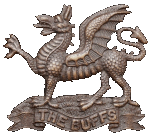Ashtead War Memorials - WWI
Pte William Matthews
7th (Service) Battalion, The Buffs (East Kent Regiment)

At Epsom for the December Quarter of 1877, one may find the marriage of James Matthews [born Soberton, Hampshire ca 1855], General Labourer, and Catherine Etherington [born Kingswood, Surrey, registered Reigate 6/1860]. In 1881 they were resident at 2 Everton Cottages, The Common, Epsom. Their union produced a number of children including William, born at Ashtead for the event to be registered in Epsom, 9/1892.
In the 1901 Census, the family, of 11 plus a lodger, was enumerated living in West Lodge, Ashtead Park, suggesting that James had obtained employment as a Gardener for Mr Pantia Ralli, Lord of the Manor.
The wedding of William Matthews to Annie Grocott [born ca 1895 Staffs.?] took place in the summer of 1915 but this couple seem to have produced no offspring.
Apparently William had moved away from his parents to Kingston upon Thames, where he enlisted for War Service on 13 January 1917, when aged 23 years and 11 months. His assignment was to 7th (Service) Battalion, The Buffs (East Kent Regiment), formed at Canterbury as part of 'Kitchener 2' and attached to 55th Brigade, 18th (Eastern) Division.
During 1917, this unit was involved in a number of actions including: -
Operations on the Ancre (notably Miraumont
and the capture of Irles)
The German retreat to the Hindenburg Line
The Third Battle of the Scarpe, a phase of the Arras
offensive
and, during Third Battle of Ypres, 31 July to 10 November,
the Battles of Pilkem Ridge, Langemarck & First Battle of
Passchendaele
The last-named operation, which took place on 12 October 1917, has been regarded as a “total failure”: -
Part of the 3rd Australian Division came under German artillery fire before the attack even started, causing confusion. Forward patrols reached Passchendaele village, but were not strong enough to hold the village and were soon forced to retreat to their starting point. The 10th Australian Brigade was stopped by machine gun fire from its flank. The New Zealand Division ran into unbroken German wire and suffered heavy losses (nearly 3,000 men) attempting to pass through a single gap in the wire. At the end of the day, all of the attacking units had been forced to pull back almost to their original position.
Rickard, J (17 August 2007), First Battle of Passchendaele, 12 October 1917
http://www.historyofwar.org/articles/battles_passchendaeleI.html
William Matthews died on 13 October 1917, 'killed in action', either as the result of wounds sustained previously or in the aftermath to 1st Passchendaele.
Poelcapelle had been re-taken by 11th Division on 4 October 1917 but the British Cemetery, where William lies, was not made until after the Armistice when remains were brought in from the surrounding battlefields and graves in smaller cemeteries.
http://www.ww1battlefields.co.uk/flanders/poelcapelle.html
text: Brian Bouchard: if you can add to this page please contact the editor
page added 10 Mar 2009